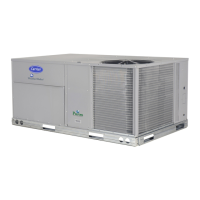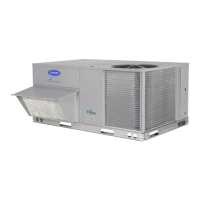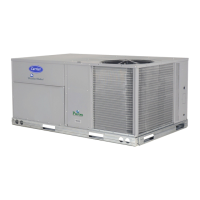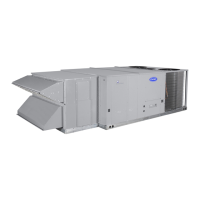84
Fig. 38 — Accessory Navigator™ Display
Carrier Comfort Network
®
(CCN) Interface
The units can be connected to the CCN if desired. The commu-
nication bus wiring is a shielded, 3-conductor cable with drain
wire and is field supplied and installed. The system elements are
connected to the communication bus in a daisy chain arrange-
ment. (See Fig. 39.) The positive pin of each system element
communication connector must be wired to the positive pins of
the system elements on either side of it. This is also required for
the negative and signal ground pins of each system element.
Wiring connections for CCN should be made at the CIB. (See
Fig. 24, 26, 28 or 29, depending on unit configuration.) Consult
the CCN Contractor’s Manual for further information.
NOTE: Conductors and drain wire must be 20 AWG (Ameri-
can Wire Gauge) minimum stranded, tinned copper. Individual
conductors must be insulated with PVC, PVC/nylon, vinyl,
Teflon
1
, or polyethylene. An aluminum/polyester 100% foil
shield and an outer jacket of PVC, PVC/nylon, chrome vinyl,
or Teflon with a minimum operating temperature range of –
20°C to 60°C is required. See the following table for accept-
able wiring.
It is important when connecting to a CCN communication bus
that a color-coding scheme be used for the entire network to
simplify the installation. It is recommended that red be used for
the signal positive, black for the signal negative and white for
the signal ground. Use a similar scheme for cables containing
different colored wires.
At each system element, the shields of its communication bus
cables must be tied together. The shield screw on CIB can be
used to tie the cables together. If the communication bus is en-
tirely within one building, the resulting continuous shield must
be connected to a ground at one point only. The shield screw
on CIB is not acceptable for grounding. If the communication
bus cable exits from one building and enters another, the
shields must be connected to grounds at the lightning suppres-
sor in each building where the cable enters or exits the building
(one point per building only). To connect the unit to the net-
work:
1. Turn off power to the control box.
2. Cut the CCN wire and strip the ends of the red (+), white
(ground), and black (–) conductors. (Substitute appropriate
colors for different colored cables.)
3. Connect the red wire to (+) terminal on CIB, the white wire
to COM terminal, and the black wire to the (–) terminal.
4. The RJ14 CCN connector on CIB can also be used, but is
only intended for temporary connection (for example, a
laptop computer running Carrier network software).
5. Restore power to unit.
Protective Devices
COMPRESSOR PROTECTION
Overcurrent
Each compressor has internal line break motor protection.
Overtemperature
Each compressor has an internal protector to protect it against
excessively high discharge gas temperatures.
High-Pressure Switch
If the high-pressure switch trips, the compressor will shut
down and the compressor safety alarm should trip. Refer to the
Alarm section for compressor safety alarms.
EVAPORATOR FAN MOTOR PROTECTION
Indoor-fan motors less than 5 hp are equipped with internal
overcurrent and overtemperature protection. Protection devices
reset automatically. Disconnect and lock out power when ser-
vicing motor. Indoor-fan motors 5 hp and larger are equipped
with a manual reset, calibrated trip, magnetic circuit breaker
and overcurrent protection. Do not bypass connections or in-
crease the size of the breaker to correct trouble. Determine the
cause and correct it before resetting the breaker. On units with
VFD, it serves as the motor thermal and over-current protec-
tion. Refer to Appendix C for more details on VFD.
CONDENSER-FAN MOTOR PROTECTION
Each condenser-fan motor is internally protected against over-
temperature.
Fuses are located in the control box and feed power to the con-
denser fan motors. Always replace blown fuses with the correct
size fuse as indicated on the unit fuse label.
SATURATED SUCTION PRESSURE (SSP)
If the SSP for a particular circuit is reading below the alarm set
point for an extended period of time, that circuit will be shut
down. After 15 minutes, the alarm will automatically reset. If
this alarm occurs 3 times consecutively, the circuit will remain
locked out until an alarm reset is initiated via CCN or manually
via the scrolling marquee display (see Alarms and Alerts sec-
tion for more details).
1. Teflon is a registered trademark of DuPont.
MANUFACTURER PART NO.
Alpha 2413 or 5463
Belden 8772
Carol C2528
West Penn 302
Ru
n Sta
tus
Service Te
st
T
emp
erature
s
P
ressures
Setpoints
Inpu
ts
Outp
uts
Con
fig
u
ra
tion
Time Clo
ck
Oper
ating
Mod
es
Alarms
ENTER
E S C
M O
DE
Ala
rm
St a
tus
TIME
EW
T
LWT
SETP
1 2 . 5 8
5 4.6°
F
4 4 .1
° F
44.0° F
N A
VIGAT OR
Com fo rt Li nk
IMPORTANT: A shorted CCN bus cable will prevent some
routines from running and may prevent the unit from starting.
If abnormal conditions occur, unplug the connector. If condi-
tions return to normal, check the CCN connector and cable.
Run new cable if necessary. A short in one section of the bus
can cause problems with all system elements on the bus.
CAUTION
EQUIPMENT DAMAGE HAZARD
Failure to follow this caution may result in damage to the
unit.
DO not bypass the VFD while running the motor. Do not
change VFD parameter associated with motor characteris-
tics, these are factory programmed for motor protection.
Damage to the motor or the VFD can occur.

